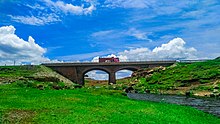Debre Berhan
Debre Berhan ( Amharic ደብረ ብርሃን däbrä bərhan [ dəbrə bɨrhan ] "Mountain of Light", also Debre Birhan ) is a town in the Amhara region in Ethiopia , 120 km northeast of Addis Ababa on the road to Dese at an altitude of 2805 m . For 2006, a population of 59,796 is expected. The city was one of the first capital cities of Ethiopia. Together with Ankobar and Angolalla , it was one of the residential cities of the Kingdom of Shewa .
history
Debre Berhan was founded during the reign of Emperor Zara Yaqob . Based on a "supernatural" light that was seen in the sky over this place. This light was interpreted as a sign of God and was associated with the stoning of 38 heretics the day before. Thereupon the emperor ordered the building of a church at this point and later an extensive palace complex followed. Another church dedicated to St. Cyriycus was built on top of it. Zara Yaqob spent 12 of the last years of his life in this place. The historian Richard Pankhurst gives the year 1456 as the date for the construction of the first church. This is justified by the fact that the light in the sky must have been Halley's comet.
Debre Berhan was for a long time a better village and meaningless. This changed under the rule of Asfa Wasan (1775-1808), who had a palace built at the site and stayed in Debre Berhan, Ankobar and Angolalla alike. His son Sahle Selassie rebuilt the place after it was devastated by an Oromo uprising and had the Trinity Church built. 1
literature
- Richard PK Pankhurst: History of Ethiopian Towns: From the Middle Ages to the Early Nineteenth Century. Franz Steiner Verlag, Wiesbaden 1982, pp. 37, 188f, 280, 190, ISBN 3-447-04672-4
Coordinates: 9 ° 41 ' N , 39 ° 32' E
